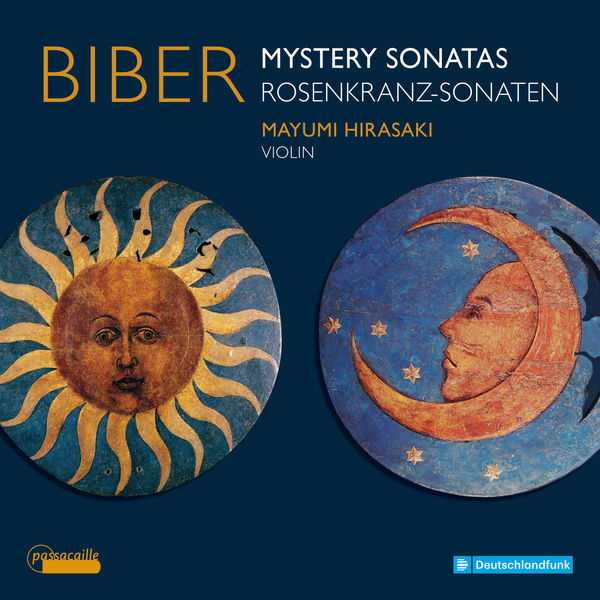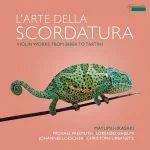
Composer: Heinrich Ignaz Franz von Biber
Performer: Mayumi Hirasaki, Michael Freimuth, Christine Schornsheim, Johannes Loescher, Jan Freiheit
Format: FLAC (tracks)
Label: Passacaille
Catalogue: PAS1088
Release: 2022
Size: 1.33 GB
Recovery: +3%
Scan: yes
Rosary Sonatas
01. No. 1 in D Minor, C. 90 “The Annunciation”: Praeludium – Aria and Variations – Finale
02. No. 2 in A Major, C. 91 “The Visitation”: Sonata – Allemanda – Presto
03. No. 3 in B Minor, C. 92 “The Nativity”: Sonata – Courente and Double – Adagio
04. No. 4 in D Minor, C. 93 “The Presentation of Jesus in the Temple”: Ciacona
05. No. 5 in A Major, C. 94 “The Discovery in the Temple”: Praeludium – Allemanda – Gigue – Sarabanda and Double
06. No. 6 in C Minor, C. 95 “Christ on the Mount of Olives”: Lamento
07. No. 7 in F Major, C. 96 “The Scourging at the Pillar”: Allamanda and Variatio – Sarabande and Variations
08. No. 8 in B-Flat Major, C. 97 “The Crown of Thorns”: Sonata – Gigue and 2 Doubles
09. No. 9 in A Minor, C. 98 “The Carrying of the Cross”: Sonata – Courente and 2 Doubles – Finale
10. No. 10 in G Minor, C. 99 “The Crucifixion”: Praeludium – Aria and 5 Variations – Adagio
11. No. 11 in G Major, C. 100 “The Resurrection”: Sonata – Surrexit Christus hodie – Adagio
12. No. 12 in C Major, C. 101 “The Ascension”: Intrada – Aria tubicinum – Allamanda – Courente and Double
13. No. 13 in D Minor, C. 102 “The Descent of the Holy Ghost”: Sonata – Gavotte – Gigue – Sarabanda
14. No. 14 in D Major, C. 103 “The Assumption of the Virgin”: Grave – Adagio – Aria and Variations – Gigue
15. No. 15 in C Major, C. 104 “The Coronation of the Virgin”: Sonata – Aria and Variations – Canzon – Sarabanda
16. No. 16 in G Minor, C. 105 “Guardian Angel”: Passacaglia (Adagio – Allegro – Adagio)
Biber’s Rosary Sonatas are without doubt among the most colourful and brilliantly virtuosic works in the entire Baroque violin literature. Their distinctive feature is the scordatura, a tuning of the violin strings individually prescribed for each sonata, which allows a more colourful differentiation of the musical characters.
For her meticulously prepared and well thought-out recording, scordatura specialist Mayumi Hirasaki has assembled a group of renowned specialists and thus presents one of the most remarkable recordings of this cycle, which never ceases to fascinate.
This form of the rosary has been in use in the Roman Catholic church for centuries as a type of Marian Psalter. It gradually became customary to add an attribute to the name of Jesus in the first part of the Hail Mary during the recitation of the rosary, linking it to one of the fifteen canonical mysteries of the Joyful, Sorrowful and Glorious Mysteries that describe the birth and salvation of the Son of God and of his Mother.
The Salzburg court musician Heinrich Ignaz Franz Biber (16441704) composed, according to his preface, fifteen sonatas “to the honour of the fifteen holy mysteries” of the Rosary, dedicating these to his prince-archbishop Max Gandolph von Kuenburg in a manuscript decorated with small medallion-like copperplate engravings. Biber, a native of Bohemia, had gone to visit to the Tyrolean master violin maker Jacobus Stainer to purchase instruments in 1670, but failed to return to his then employer, Karl von Liechtenstein-Kastelkorn, Bishop of Olomouc, who resided in Kremsier. Biber, who had presumably taken advantage of lessons for some time with Johann Heinrich Schmelzer, violinist to the Imperial court in Vienna, apparently preferred to take up a position at the Salzburg court.
The above manuscript, the only known source of the Mystery or Rosary Sonatas the prime reason that Biber is known to today’s musicians accords with the structure of the chain of prayers. This cycle of sonatas was most probably known only to the Salzburg prince-archbishop and his chamber musicians during Biber’s lifetime.



